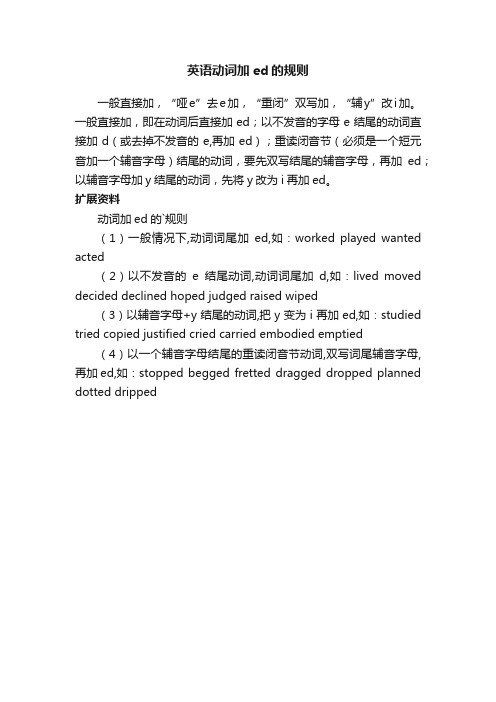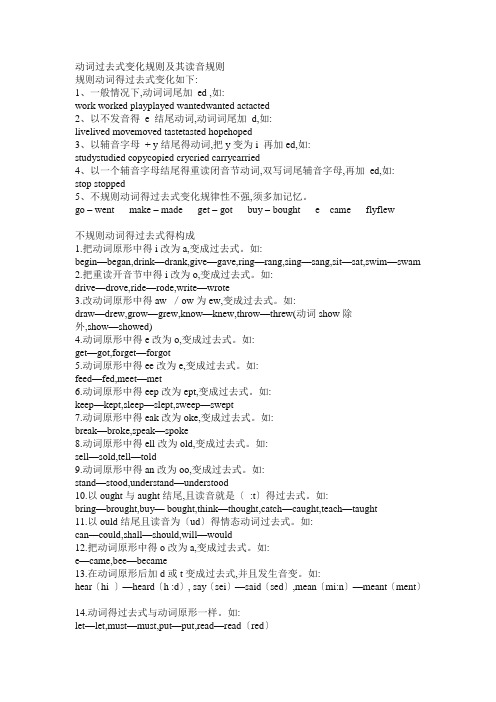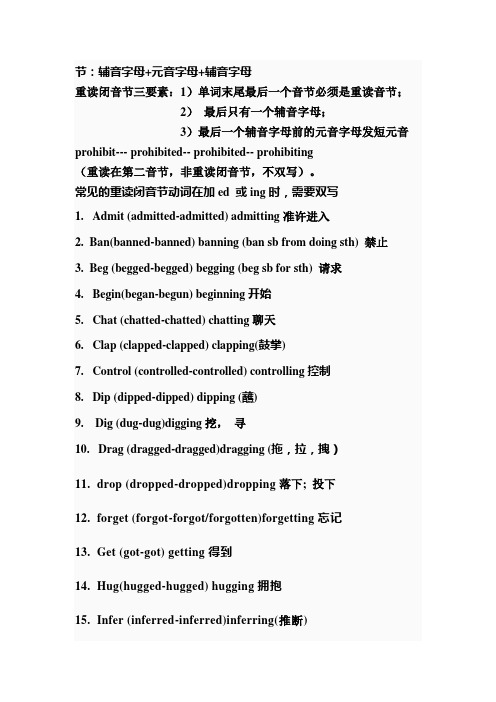常见的重读闭音节动词在加ed或ing时
动词加ing的规则

动词加ing的规则
动词+ing的规则是:
1. 一般情况下,动词加-ing直接在动词的末尾加上-ing。
例如:run(跑)→ running(跑着)
2. 以不发音的字母e结尾的动词,在加-ing时,需去掉字母e再加上-ing。
例如:take(拿)→ taking(拿着)
3. 以重读闭音节结尾,并且结尾只有一个辅音字母的动词,双写这个辅音字母,再加-ing。
例如:stop(停止)→ stopping(停止着)
4. 以一个元音字母(除了e)结尾,并且结尾只有一个辅音字母的动词,双写这个辅音字母,再加-ing。
例如:sit(坐)→ sitting(坐着)
5. 以“辅音字母+元音字母+辅音字母”结尾的动词,重读最后一个音节,双写最后一个辅音字母,再加-ing。
例如:get(得到)→ getting(得到着)
6. 以"ie"结尾的动词,将"ie"变成"y"再加-ing。
例如:lie(躺)→ lying(躺着)
需要注意的是,这只是动词加-ing的一些一般规则,部分动词可能会有特殊情况,需要根据具体内容进行考虑和判断。
英语动词加ed的规则

英语动词加ed的规则
一般直接加,“哑e”去e加,“重闭”双写加,“辅y”改i加。
一般直接加,即在动词后直接加ed;以不发音的字母e结尾的动词直接加d(或去掉不发音的e,再加ed);重读闭音节(必须是一个短元音加一个辅音字母)结尾的动词,要先双写结尾的辅音字母,再加ed;以辅音字母加y结尾的动词,先将y改为i再加ed。
扩展资料
动词加ed的`规则
(1)一般情况下,动词词尾加ed,如:worked played wanted acted
(2)以不发音的e结尾动词,动词词尾加d,如:lived moved decided declined hoped judged raised wiped
(3)以辅音字母+y结尾的动词,把y变为i再加ed,如:studied tried copied justified cried carried embodied emptied (4)以一个辅音字母结尾的重读闭音节动词,双写词尾辅音字母,再加ed,如:stopped begged fretted dragged dropped planned dotted dripped。
动词加ed和ing规则精编版

动词过去式变化规则及其读音规则规则动词的过去式变化如下:1、一般情况下,动词词尾加-ed ,如:work ---worked play---played wanted----wanted act----acted2、以不发音的-e 结尾动词,动词词尾加-d,如:live---lived move----moved taste---tasted hope---hoped3、以辅音字母+ y结尾的动词,把-y变为-i 再加-ed,如:study---studied copy---copied cry---cried carry---carried4、以一个辅音字母结尾的重读闭音节动词,双写词尾辅音字母,再加-ed,如:stop ---stopped5、不规则动词的过去式变化规律性不强,须多加记忆。
go – went make – made get – got buy – bought come - came fly-flew不规则动词的过去式的构成1.把动词原形中的i改为a,变成过去式。
如:begin—began,drink—drank,give—gave,ring—rang,sing—sang,sit—sat,swim—swam2.把重读开音节中的i改为o,变成过去式。
如:drive—drove,ride—rode,write—wrote3.改动词原形中的aw /ow为ew,变成过去式。
如:draw—drew,grow—grew,know—knew,throw—threw(动词show除外,show—showed)4.动词原形中的e改为o,变成过去式。
如:get—got,forget—forgot5.动词原形中的ee改为e,变成过去式。
如:feed—fed,meet—met6.动词原形中的eep改为ept,变成过去式。
如:keep—kept,sleep—slept,sweep—swept7.动词原形中的eak改为oke,变成过去式。
初中阶段动词需双写最后一个字母再加ing ed小结

.1 、以重读闭音节结尾,末尾只有一个辅音字母的动词,即一个元音加一个辅音结尾并且重读时(重读闭音节)要双写这一辅音字母,再加-ing。
例如: run-running, swim-swimming 等。
(或在重读闭音节里,末尾只有一个辅音字母,辅音字母前只有一个元音字母时,要双写这个辅音字母。
辅-元-辅好像更好记 )内在的道理就是:动词+ing 或+ed 后,必须保证主干的发音不变正确: cutting 分成两个音节:cut.ting,前半部分发音和动词原型 cut 一样.错误: cuting 分成两个音节:cu.ting,前半部分发音就变了. 所以,对于重读单元音后只有一个辅音字母结尾的,必须双写这个辅音字母。
如果不双写,那么,这个辅音字母和 ing 或 ed 组成音节,前面的音节就由闭音节变成开音节了!双写一般是为了使读音不便,但有时,双写会使读音发生变化,如 write 的过去分词是written, 所以: write 中的 i 是开音节,读成[ai],written 中的i 由于双写了 t 变成了闭音节,读成[i]。
很简单地说:就是一个单词无论多长,在考虑是否“双写”时,只需要看最后3 个字母即可--即如果最后 3 构成的话,那么这个单词就需要“双写”,如果不是,那么就不用了。
这个单词,虽说结尾 3 个字母符合“辅元辅”规则,但是这个单词却不双写,而是 listening.( 1) . 必须是重读音节;( 2) . 最后只有一个辅音字母;( 3) .元音字母发短元音如: begin ,ap/ple a p 就是一个闭音节2、以-al,-er,-ill,-el 结尾的动词,即使重音不在最后一个音节上,也要双写,再加-ing 如:travelling 等。
3、在最后一个字母不是 A E I O U其中一个时,而最后一个字母的前一个字母是 A E I OU(元音)其中一个时,就要双写最后一个字母,但如果而比如说: forget- forgetting travel- travelling.我们老师说就像汉堡包一样结构:归纳如下:动词 ing 形式双写的有:动词加 ed 双写的有:,.drip dripping初中英语动词中,字母双写的情况:双写加 ing,双写加ed ,规则:在重读闭音节里,末尾只有一个辅音字母,辅音字母前只有一 个元音字母时,要双写这个辅音字母。
动词加ed和ing规则

动词过去式变化规则及其读音规则规则动词得过去式变化如下:1、一般情况下,动词词尾加ed ,如:work worked playplayed wantedwanted actacted2、以不发音得e 结尾动词,动词词尾加d,如:livelived movemoved tastetasted hopehoped3、以辅音字母+ y结尾得动词,把y变为i 再加ed,如:studystudied copycopied crycried carrycarried4、以一个辅音字母结尾得重读闭音节动词,双写词尾辅音字母,再加ed,如:stop stopped5、不规则动词得过去式变化规律性不强,须多加记忆。
go – went make – made get – got buy – bought e came flyflew不规则动词得过去式得构成1.把动词原形中得i改为a,变成过去式。
如:begin—began,drink—drank,give—gave,ring—rang,sing—sang,sit—sat,swim—swam 2.把重读开音节中得i改为o,变成过去式。
如:drive—drove,ride—rode,write—wrote3.改动词原形中得aw /ow为ew,变成过去式。
如:draw—drew,grow—grew,know—knew,throw—threw(动词show除外,show—showed)4.动词原形中得e改为o,变成过去式。
如:get—got,forget—forgot5.动词原形中得ee改为e,变成过去式。
如:feed—fed,meet—met6.动词原形中得eep改为ept,变成过去式。
如:keep—kept,sleep—slept,sweep—swept7.动词原形中得eak改为oke,变成过去式。
如:break—broke,speak—spoke8.动词原形中得ell改为old,变成过去式。
动词ing形式变化规则口诀

动词ing形式变化规则口诀动词ing形式变化规则常见的几种情况分别是:一般情况直接+ing;以不发音e结尾的去e+ing;重读闭音节一个辅音字母结尾,双写辅音字母+ing。
1、一般动词,变化:加+ing,例子:wash——washing,read——reading2、以不发音字母e结尾的动词,变化:去掉e,再加+ing,例子:make——makingwrite——writinguse——using3、以重读闭音节结尾的动词且末尾只有一个辅音字母,变化:双写最后的辅音字母,再加+ing,例子:run——running,swim——swimming,put——putting4、以ie结尾的动词,变化:改ie为y,再加+ing,例子:lie——lyingdie——dying,tie——tying5、以c结尾的动词,变化:变c为ck,再加+ing ,例子:picnic→picnicking,traffic→trafficking(例外:arc作弧形运动,arcing)6、以l结尾的动词,变化:如果动词原形以非重读音节结尾,则末尾的字母l双写与不双写均可。
其中不双写的是美式拼写。
例子:tavel→travelling/travelingU.S.7、部分以-p结尾的动词,变化:同样遵循第6条,这类词多由“前缀+名词”构成。
如果动词原形以非重读音节结尾,则末尾的字母p双写与不双写均可。
其中不双写的是美式拼写。
例子:worship→worshipping/worshipingU.S.,handicap→handicapping/handicapingU.S.直接在动词后面加ing。
例如:原词:read + ing →reading(读)原词:draw + ing →drawing(画)原词:listen + ing →listening(听)以x、w、y结尾的动词,直接加ing。
例如:原词:fix + ing →fixing(修理)原词:follow + ing →follow(跟随)原词:employ + ing →employing(雇用)以元音字母加e结尾,或以e结尾,且e发音的动词(ee,oe,ye),直接加ing 。
动词加-ing、-ed,-es的规则

动词加-ing, -s/ -es, -ed及名词加-s /-es的规则汇总一动词+ing:1 一般情况下,直接在动词后加-ing2 动词以不发音的-e结尾,要去-e加-ing3 重读闭音节并且是由一个元音字母加一个辅音字母结尾的动词,要双写辅音字母再加-ing4 以-ie结尾的动词,把-ie变成y再加-ingwork _______ study _______ take _______make _______ cut _______ put _______begin _______ lie _______ tie _______ die _______二动词+s / es (名词变复数的规则相同!)1 一般情况下,在动词后+s2 以辅音字母+y结尾的动词,把y改为i,再加es (元音字母+y的单词直接加s)3 以s, x, ch,sh, o结尾的动词加es. (以o结尾的名词,一般下面的词加es:Negro—Negroes 、hero—heroes 、tomato—tomatoes 、potato—potatoes )get_______ s tay________ watch_______ w ish_______fix_______ do _________ go_______ pass_______try_______ study_______ c ry_______ fly_________三动词+ed:1 一般情况下,动词词尾加ed (以e结尾的单词只要加d就可以了)2 以辅音字母+ y结尾的动词,把y变为i 再加ed,3 以一个辅音字母结尾的重读闭音节动词,双写词尾辅音字母,再加ed,live_______ move_______ judge_______ wipe_______study_______ copy_______ cry_______ carry_______empty_______ stop_______ beg_______ drag_______drop_______ plan_______ drip_______答案:一:working studying taking making cutting putting beginning lying tying dying二:gets stays watches wishes fixes doesgoes passes tries studies cries flies三:lived moved judged wiped studied copiedcried carried emptied stopped begged draggeddropped planned dripped【本文档内容可以自由复制内容或自由编辑修改内容期待你的好评和关注,我们将会做得更好】。
常见的重读闭音节动词在加ed 或ing时

节:辅音字母+元音字母+辅音字母重读闭音节三要素:1)单词末尾最后一个音节必须是重读音节;2)最后只有一个辅音字母;3)最后一个辅音字母前的元音字母发短元音prohibit--- prohibited-- prohibited-- prohibiting(重读在第二音节,非重读闭音节,不双写)。
常见的重读闭音节动词在加ed 或ing时,需要双写1. Admit (admitted-admitted) admitting准许进入2. Ban(banned-banned) banning (ban sb from doing sth) 禁止3. Beg (begged-begged) begging (beg sb for sth) 请求4. Begin(began-begun) beginning开始5. Chat (chatted-chatted) chatting聊天6. Clap (clapped-clapped) clapping(鼓掌)7. Control (controlled-controlled) controlling控制8. Dip (dipped-dipped) dipping (蘸)9. Dig (dug-dug)digging挖,寻10. Drag (dragged-dragged)dragging (拖,拉,拽)11. drop (dropped-dropped)dropping落下; 投下12. forget (forgot-forgot/forgotten)forgetting忘记13. Get (got-got) getting得到14. Hug(hugged-hugged) hugging拥抱15. Infer (inferred-inferred)inferring(推断)16. Nod(nodded-nodded) nodding点头17. Occur(occurred-occurred) occurring发生18. Pat (patted-patted) patting拍打19. Permit(permitted-permitted) permitting允许20. Pin(pinned-pinned) pinning(别针,别)21. Plan(planned-planned) planning计划22. Prefer (preferred-preferred) preferring更喜欢23. Regret (regretted-regretted) regretting遗憾,后悔24. Rob (robbed-robbed) robbing(rob sb of sth)抢夺25. Ship(shipped-shipped)shipping(用船运)26. Shop(shopped-shopped)shopping购物27. Sit (sat-sat)sitting坐28. Skip (skipped-skipped)skipping(跳,跳读,遗漏)29. Sob(sobbed-sobbed) sobbing(啜泣)30. Star(starred-starred)starring(主演)31. Step (stepped-stepped)stepping脚步,踏入32. Stop (stopped-stopped) stopping停止33. Swim (swam-swum) swimming游泳34. Tap(tapped-tapped) tapping(轻敲)35. Trap(trapped-trapped)trapping(圈套)36. Win(won-won) winning赢37. Wrap(wrapped-wrapped) wrapping包裹,包装38. Cut (cut-cut) cutting切39. Fit(fit-fit) fitting安装;使……适应;使……合身40. Hit(hit-hit) hitting打,打击; 碰撞41. Let(let-let)letting允许,任由;让42. Put (put-put)putting放43. Set (set-set) setting安装,设置44. Shut(shut-shut)shutting关45. Spit (spit-spit)spitting .吐,吐口水46. Split(split-split)splitting劈开, (使)裂开, 分裂, 分离47.Equip equipped equipping 装备,安装48stir----stirred----stirring搅拌;激起;惹起49rub----rubbed----rubbing擦,摩擦;用…擦;触怒注意:Write wrote written writingPlay played played playingPay paid paid payingDestroy destroyed destroyed destroying Study studied studied studyingLie 撒谎lied lied lyingLie 位于,平躺lay lain lying Lay 放置,下蛋laid laid laying Die died died dyingFly flew flown flying常见形容词Big大的bigger, biggestHot热的hotter hottestRed红色的redder reddestThin廋的thinner thinnestFat胖的fatter fattestSlim 苗条的slimmer slimmestWet湿的wetter wettestSad难过的sadder saddest。
- 1、下载文档前请自行甄别文档内容的完整性,平台不提供额外的编辑、内容补充、找答案等附加服务。
- 2、"仅部分预览"的文档,不可在线预览部分如存在完整性等问题,可反馈申请退款(可完整预览的文档不适用该条件!)。
- 3、如文档侵犯您的权益,请联系客服反馈,我们会尽快为您处理(人工客服工作时间:9:00-18:30)。
节:辅音字母+元音字母+辅音字母
重读闭音节三要素:1)单词末尾最后一个音节必须是重读音节;
2) 最后只有一个辅音字母;
3) 最后一个辅音字母前的元音字母发短元音prohibit--- prohibited-- prohibited-- prohibiting
(重读在第二音节,非重读闭音节,不双写)。
常见的重读闭音节动词在加ed或ing时,需要双写
1. Admit (admitted-admitted) admitting 准许进入
2. Ban(banned-banned) banning (ban sb from doing sth禁止
3. Beg (begged-begged) begging (beg sb for st请求
4. Begin(began-begun) beginnings始
5. Chat (chatted-chatted) chatting聊天
6. Clap (clapped-clapped) clapping鼓掌)
7. Control (controlled-controlled) controlling控制
8. Dip (dipped-dipped) dipping 蘸)
9. Dig (dug-dug)digging 挖,寻
10. Drag (dragged-dragged)dragging 拖,拉,拽)
11. drop (dropped-dropped)dropping 落下; 投下
12. forget (forgot-forgot/forgotten)forgetting 忘记
13. Get (got-got) getting 得到
14. Hug(hugged-hugged) hugging 拥抱
15. Infer (inferred-inferred)inferring( 推断)
16. Nod(nodded-nodded) nodding 点头
17. Occur(occurred-occurred) occurring 发生
18. Pat (patted-patted) patting 拍打
19. Permit(permitted-permitted) permitting 允许
20. Pin(pinned-pinned) pinning (别针,别)
21. Plan(planned-planned) planning 计戈U
22. Prefer (preferred-preferred) preferring 更喜欢
23. Regret (regretted-regretted) regretting 遗憾,后悔
24. Rob (robbed-robbed) robbing(rob sb of sth)抢夺
25. Ship(shipped-shipped)shipping(用船运)
26. Shop( shopped-shopped) shopping 购物
27. Sit (sat-sat)sitting 坐
28. Skip (skipped-skipped)skipping(跳,跳读,遗漏)
29. Sob( sobbed-sobbed) sobbing(啜泣)
30. Star ( starred-starred)starring(主演)
31. Step ( stepped-stepped) stepping 脚步,踏入
32. Stop (stopped-stopped) stopping 停止
33. Swim (swam-swum) swimming 游泳
34. Tap(tapped-tapped) tapping(轻敲)
35. Trap (trapped-trapped ) trapping(圈套)
36. Win(won-won) winning 赢
37. Wrap(wrapped-wrapped) wrapping 包裹,包装
38. Cut (cut-cut) cutting 切
39. Fit(fit-fit) fitting 安装;使……适应;使……合身
40. Hit(hit-hit) hitting 打,打击;碰撞
41. Let(let-let)letting 允许,任由;让
42. Put (put-put)putting 放
43. Set (set-set) setting 安装,设置
44. Shut(shut-shut)shutting 关
45. Spit (spit-spit)spitting .吐,吐口水
46. Split ( split-split)splitting 劈开,(使)裂开,分裂,分离
47. Equip equipped equipping 装备,安装
48stir----stirred----stirring 搅拌;激起;惹起
49rub----rubbed----rubbing 擦,摩擦;用…擦;触怒
注意:
Write wrote written
Play played played Pay paid
paid
Destroy
Study
lied lying
lain lying
laid laying
dying flying
Big 大的bigger, biggest
Hot 热的hotter hottest
Red 红色的redder reddest Thin 廋的thinner thinnest
writing
playing
paying destroying studying
destroyed destroyed
studied studied Lie撒谎lied
Lie 位于,平躺lay
Lay 放置,下蛋laid
Die died died
Fly flew flown
常见形容词
Fat 胖的fatter fattest
Slim 苗条的slimmer slimmest Wet 湿的wetter wettest
Sad 难过的sadder saddest。
